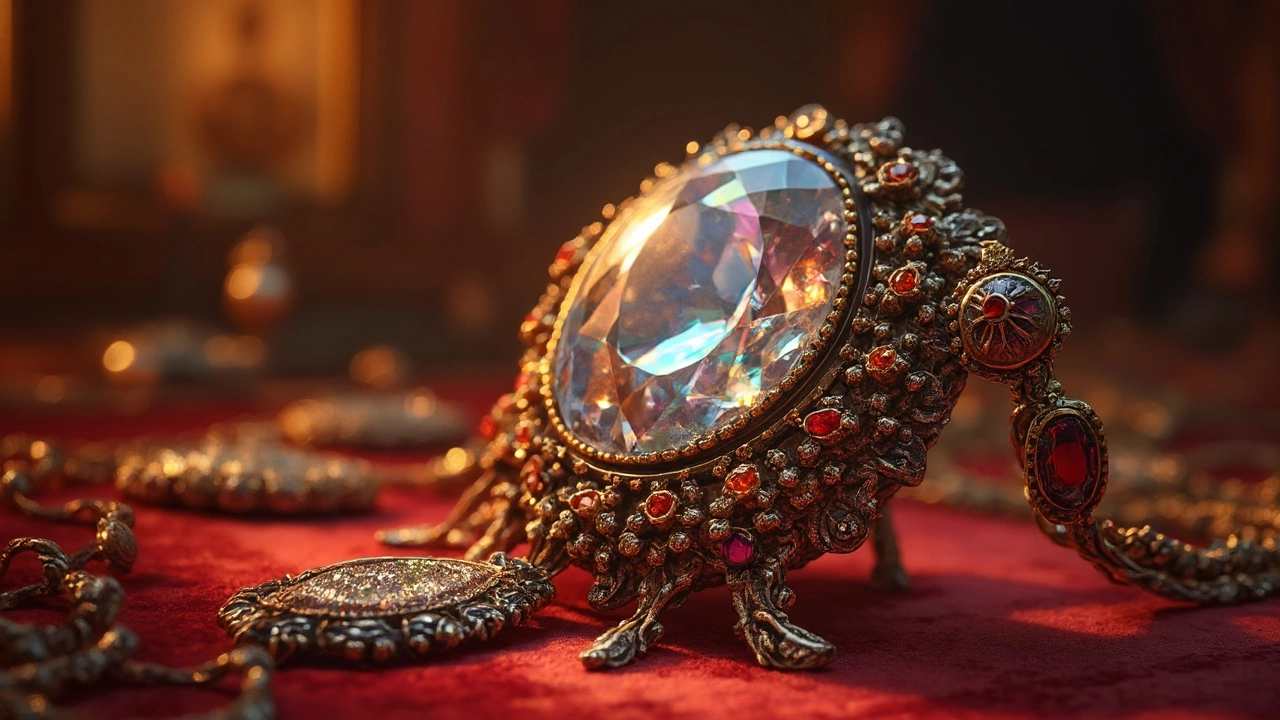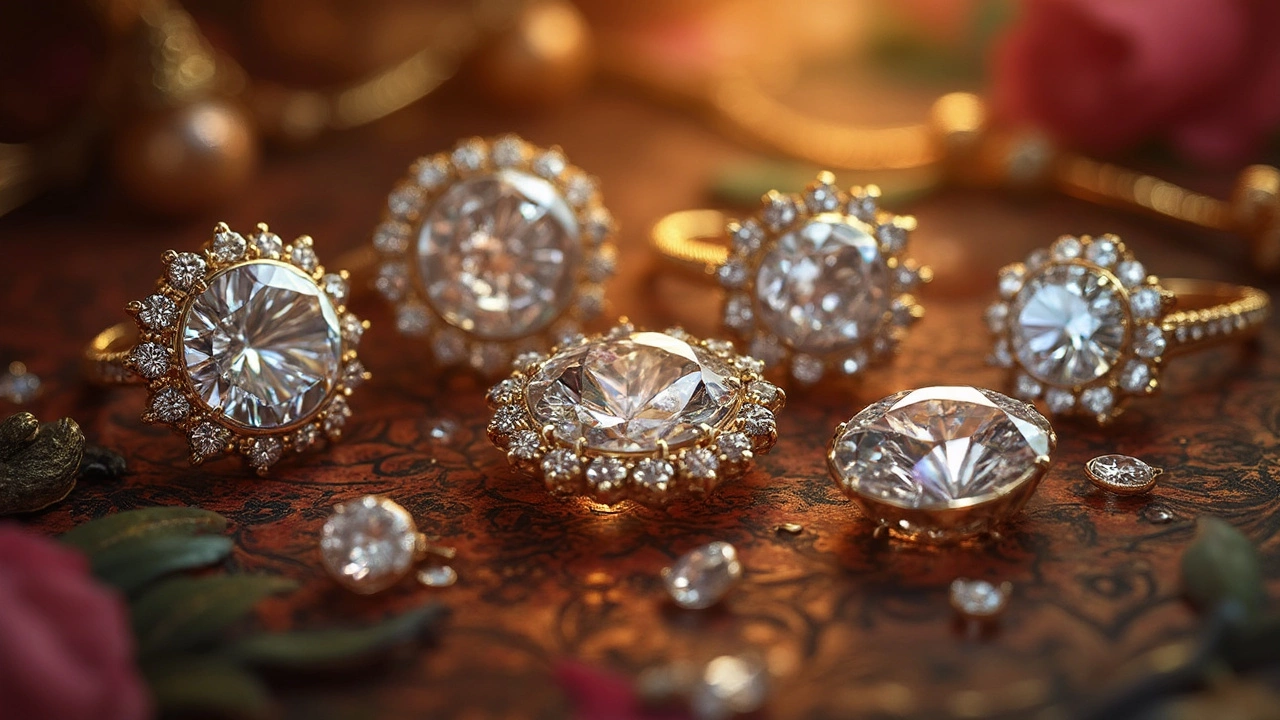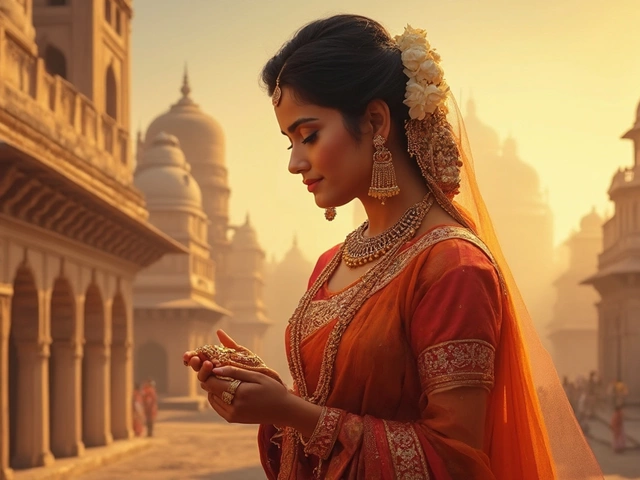
When we talk about diamonds, the first thing that comes to most folks' minds is their sparkle. But did you know that the cut of a diamond is what really makes it shine? Yep, the magic isn’t just in the stone—it’s also in how it’s shaped. This is especially true for antique jewelry, where the diamond cut plays a massive role in the piece's final look.
Now, if you’re into classic styles or you’ve inherited an old brooch, you might wonder why certain diamond cuts seem to appear over and over. There's a good reason for that: each cut tells a story and adds a unique style and vibe to the jewelry. And these cuts aren't just relics of the past—they're still making waves today.
If you've ever admired an old ring or necklace and wondered what makes it so captivating, it might just be the craftsmanship in the diamond cut. Lots of folks don’t realize that, in antique designs, the diamond's cut can actually be more critical than its color or clarity.
- Understanding Diamond Cuts
- Historical Significance of Cuts
- The Allure of the Cushion Cut
- Why the Old Mine Cut is a Gem
- Modern vs. Antique Diamond Cuts
- Tips for Choosing the Right Cut
Understanding Diamond Cuts
Ever wondered what really gives a diamond its incredible sparkliness? Spoiler alert: it's mostly about the cut. The diamond cut is the one thing you can't overlook if you're after that jaw-dropping glimmer on your antique piece. It's not just about how the stone is shaped, but how each angle and facet makes light do its spectacular dance.
In the world of antique jewelry, diamond cuts are everything. When folks back in the day crafted these beauties, they didn't have all the high-tech tools we’ve got now. Their craftsmanship was all about hands-on skill, which gives each old cut a story of its own.
Diamonds don't just pop out of the ground with those perfect angles. The cut determines how light travels within the diamond, which affects the stone's sparkle factor. A poorly cut diamond might as well be a piece of glass, while a well-cut one can catch the light from across the room.
"The cut of a diamond—more than any other factor—determines how much it will sparkle." - Gemological Institute of America
Now, let's talk specifics. There are more diamond cuts than Baskin-Robbins has ice cream flavors, but some are total classics in antique designs. Here’s what you might see pop up:
- Old Mine Cut: Often called the 'grandfather' of modern cuts, this one's got a high crown, small table, and rounded corners, making it super unique in today's market.
- Cushion Cut: Known for its pillow-like appearance, its rounded corners and larger facets increase brilliance and highlight clarity.
- Rose Cut: With a flat back and domed top that's covered in triangular facets, this cut's all about a softer, more subtle shine.
So if you're shopping for diamonds, especially the desirable diamond types found in old-world jewelry, remember: the cut's way more critical than you might think. It’s your ticket to getting that starry-eyed sparkle, no matter how old or new the piece might be.
Historical Significance of Cuts
Diamonds have been cherished for centuries, and their cuts have a fascinating history that ties into cultural shifts and technological advancements. Back in the day, the tools weren't as advanced as now, so the cuts were more about making the most of the stone's natural shape. The old mine cut, for instance, dates back to the 18th century. It's got this square shape with slightly rounded edges and a high crown. Jewelers of the past made it by hand, giving each stone a unique charm. People love these for their historical significance, often spotted in antique jewelry.
Then came the 19th century, where the industrial revolution shook things up. With new tools, jewelers started crafting stones into the cushion cut—a shape that took the best of the old mine style but with a softer, more classic look. This cushion cut became popular because it worked so well with the candlelight of the time, giving jewelry a romantic glow that just isn't the same with modern lights.
Fast forward to the early 20th century, and we've got the introduction of the modern round brilliant cut. But even as this new style gained ground, those traditional cuts kept a special place in the hearts of vintage lovers. They offer a sense of nostalgia and elegance that's hard to replicate with modern styles.
Interestingly, many antique jewelry aficionados prefer these historical cuts not just for their beauty, but for the stories they tell. Each piece with an old mine or cushion cut diamond connects the wearer to its rich past. So next time you're admiring an old ring or necklace, remember, it's not just about the bling; it's about the journey it's been on.
The Allure of the Cushion Cut
Alright, let’s talk about why the cushion cut diamond is such a hot topic when it comes to antique jewelry. Known for its pillow-like shape, this cut has been around for around two centuries. Yeah, it’s that timeless! Originally known as the 'mine cut,' it evolved into the cushion cut we know today, keeping that old-world charm intact while offering some modern sparkle.
One of the main reasons folks love the cushion cut is its ability to capture light. It’s not just about the shape; it’s how that shape works with light that counts. This cut typically features larger facets, and they create that classic, romantic look that just screams vintage elegance.
What really sets this cut apart is its versatility. You can find it in various settings, whether you want something simple or decked out with loads of details. Its rounded corners and larger surface area make it perfect for those who want their jewelry to stand out without screaming for attention.
Many of us love a good story, and with cushion cut diamonds, it's all about the craftsmanship. Imagine how these were crafted before all the fancy tech we have now. Each diamond was unique, and you can see the human touch in each facet. This gives these diamonds a kind of character you just don’t find in more modern cuts.
And hey, if you're hunting for the perfect antique piece, why settle for anything less than a cut that's worn its charm for over a hundred years? The cushion cut shines bright in the antique jewelry world for a reason—its timeless appeal is hard to ignore.

Why the Old Mine Cut is a Gem
The Old Mine Cut is like the vintage vinyl of the diamond world—it’s got that nostalgic charm that makes antique jewelry lovers swoon. If you've held an Old Mine Cut diamond, you've probably noticed its unmistakable look: it's got a slightly squared shape with rounded edges. This cut often features a high crown and a small table, which was the style back in the day when diamonds were cut by hand.
What makes this cut stand out is its bold brilliance. Thanks to its depth and unique facet arrangement, it catches light in a way that gives off a beautiful, warm glow. This is a big deal because back then, they didn't have the high-tech tools we use today to maximize sparkle, so the artisans relied on their skills and a good eye. Talk about craftsmanship!
Back in the 18th and 19th centuries, this cut was all the rage. It’s often found in antique jewelry pieces from the Georgian and Victorian eras. Why so popular? Well, back then, diamond cutters were working with the natural shapes of the rough stones, and the Old Mine Cut was perfect for that.
For those who appreciate history, an Old Mine Cut diamond is like holding a little piece of the past. Plus, it pairs wonderfully with the intricate designs typical of old jewelry. So, if you’re on the lookout for a diamond with character and a story, this cut might just be your perfect match.
An interesting nugget: because these cuts were designed to sparkle under candlelight, they give off a softer, almost romantic glow compared to modern diamonds. This quality makes them a favorite among collectors and those who love authentic antique jewelry designs.
Though not easy to find, getting your hands on one of these gems can be worth the treasure hunt. They’re not commonly produced today, so demand remains high, making them a valuable asset in the antique jewelry market. If you're ever browsing through estate sales or antique shops, keep an eye out for these unique pieces—you just might stumble across a hidden gem!
Modern vs. Antique Diamond Cuts
Figuring out what makes modern diamonds stand out from antique diamonds is like comparing a new electric car to a classic vintage ride—they're both fantastic, but for different reasons. One of the main differences has to do with how the diamonds are cut. And believe me, that cut can mean the world when it comes to sparkle and style.
Back in the day, let's say the 1800s or early 1900s, cutters didn’t have the high-tech tools we use now. They relied more on skill and a good eye. The cuts were often thicker and less precise, giving what we call an old mine cut or the cushion cut. These cuts have an unmistakable charm and a soft glow that’s super attractive to antique jewelry lovers.
Now, jump to today, and you’ll find we have lasers and computer-aided design making cuts like the popular brilliant cut. This cut is all about precision, giving diamonds that super sparkly look everyone goes crazy for. It’s like seeing the latest blockbuster movie compared to a classic black-and-white film.
Here's a little comparison to summarize:
| Feature | Modern Cuts | Antique Cuts |
|---|---|---|
| Precision | Highly precise, with lasers and technology | Handcrafted and less precise |
| Sparkle | Very sparkly with lots of brilliance | Softer glow, more romantic |
| Popularity | Widely used in contemporary designs | Favored in vintage and bespoke jewelry |
When you're out shopping for jewelry or just appreciating the pieces you already have, noticing these differences can change how you see them. Every cut is a little piece of history or technology wrapped up in something small enough to fit on your finger. It’s pretty cool when you think about it!
Whether you're after that ultra-bright bling or a hint of old-world romance, there’s a cut for everyone. Just remember, the right one is the one that makes your heart sing.
Tips for Choosing the Right Cut
So, you're ready to pick the perfect diamond, huh? Well, getting the right diamond cut is like grabbing the cherry on top of your dream sundae; it makes everything just right. Here’s how you can make that decision a whole lot easier.
First off, think about the antique jewelry style you're going for. Are you feeling the vintage vibes of old Hollywood glam with large, sparkling rocks, or are you more of a subtle elegance kind of person? Your diamond's cut will play into that aesthetic big time.
Next up, consider the setting. The way the diamond is held affects which cuts will look the best. Open settings, for example, pair beautifully with a cushion cut or an old mine cut because they allow more light to shine through, enhancing that lovely sparkle.
- Check the brilliance: A well-cut diamond will light up a room. Look for a cut that reflects light in all the right ways—no one wants a dull diamond!
- Consider the size: Cuts like marquise or pear can make the diamond appear larger than its carat weight suggests. If you're going for something bold, this is a hot tip.
- Think beyond trends: While modern cuts can be a hit, an antique piece often calls for cuts with historical flair and charm.
Finally, keep your budget in mind. Different cuts can affect cost, with fancy shapes sometimes trimming the budget fat a little.
| Cut Type | Popularity | Typical Uses |
|---|---|---|
| Cushion Cut | High | Rings, Earrings |
| Old Mine Cut | Medium | Rings, Pendants |
Whatever you choose, just remember that the right cut is ultimately about what speaks to you. Your diamond's sparkle should reflect your unique taste and style, making every glance a moment of joy.


